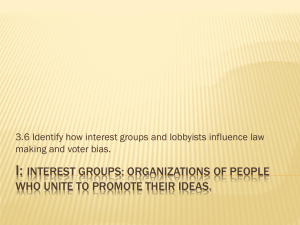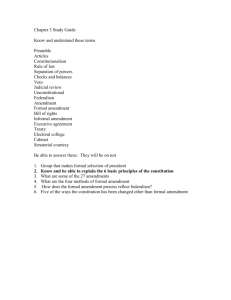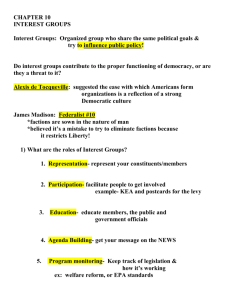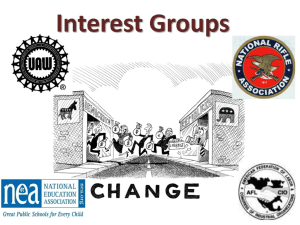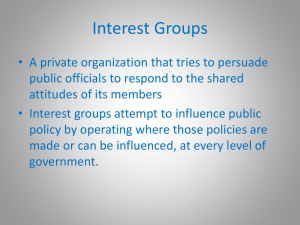Test Four, Unit Two
advertisement
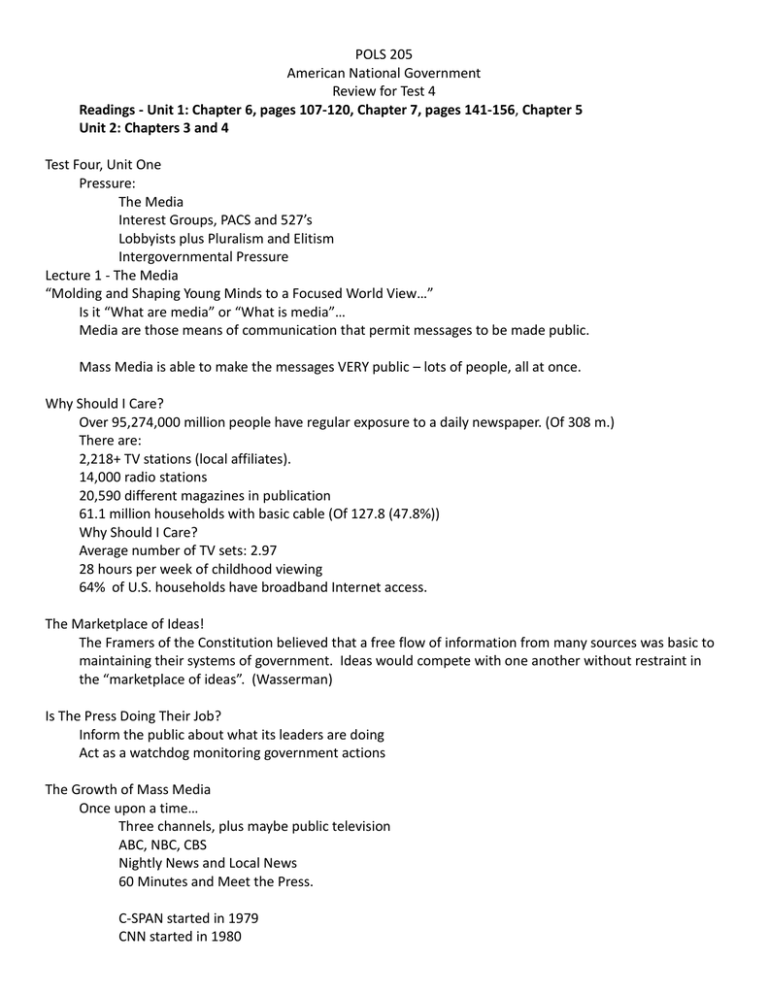
POLS 205 American National Government Review for Test 4 Readings - Unit 1: Chapter 6, pages 107-120, Chapter 7, pages 141-156, Chapter 5 Unit 2: Chapters 3 and 4 Test Four, Unit One Pressure: The Media Interest Groups, PACS and 527’s Lobbyists plus Pluralism and Elitism Intergovernmental Pressure Lecture 1 - The Media “Molding and Shaping Young Minds to a Focused World View…” Is it “What are media” or “What is media”… Media are those means of communication that permit messages to be made public. Mass Media is able to make the messages VERY public – lots of people, all at once. Why Should I Care? Over 95,274,000 million people have regular exposure to a daily newspaper. (Of 308 m.) There are: 2,218+ TV stations (local affiliates). 14,000 radio stations 20,590 different magazines in publication 61.1 million households with basic cable (Of 127.8 (47.8%)) Why Should I Care? Average number of TV sets: 2.97 28 hours per week of childhood viewing 64% of U.S. households have broadband Internet access. The Marketplace of Ideas! The Framers of the Constitution believed that a free flow of information from many sources was basic to maintaining their systems of government. Ideas would compete with one another without restraint in the “marketplace of ideas”. (Wasserman) Is The Press Doing Their Job? Inform the public about what its leaders are doing Act as a watchdog monitoring government actions The Growth of Mass Media Once upon a time… Three channels, plus maybe public television ABC, NBC, CBS Nightly News and Local News 60 Minutes and Meet the Press. C-SPAN started in 1979 CNN started in 1980 MSM vs. Alternative Sources Main Stream Media Liberal and Conservative sources Late Night “fake news” – 20% Just Add Water! Instant News The 24 Hour News Cycle: How will this look on the 6:00 news? Friday at 5:00 news dump The internet and the “blogosphere” have added speed and intensity to generate a near constant “crisis mode” We are losing time for ANALYSIS. The Menu of Messages News Reports Entertainment Advertising News Reports Roles of the press: Gatekeeper Influences what subjects become national political issues Score Keeper Help make political reputations Especially important in primary races Watchdog Close scrutiny An instinctive desire to expose scandals and investigate personalities News Reports Problems With the Press: Sensationalism: If it bleeds, it leads; if it burns, it turns heads Selectivity What’s News, What Isn’t Agenda Setting Surreptitious bias Everyone has a point of view I’d rather listen to someone who recognizes that they have a bias. Unfortunately, that’s “rather” rare. Entertainment and Advertisement Entertainment Defining what is “Normal” The Oprah/Jerry Springer/Dr. Phil effect Advertisiment Most of the profits in the media industry come from: Advertising 60% of Presidential campaign funds are spent on advertising 30 Seconds of Superbowl airtime is just over $2.6 million bucks in 2010! They KNOW it is effective or they wouldn’t pay so much for it. It WORKS! What About When They Interbreed? Infotainment Product Placement Oprah! Politics and the Media Press Secretary http://www.whitehouse.gov/briefing_room/PressBriefings/ Robert Gibbs The “Bully Pulpit” Lend me your ears, and “Hey, watch this!” Good News from the Original Embedded Reporters: Then you will know the truth, and the truth will set you free. Jesus to the Children of Abraham in John 8:32 John 16:33 "I have told you these things, so that in me you may have peace. In this world you will have trouble. But take heart! I have overcome the world." Under Pressure! Lecture 2 - Interest Groups and PACs Alexis de Tocqueville (1805–59) Americans combine to give fêtes, found seminaries, build churches, distribute books, and send missionaries to the antipodes. Hospitals, prisons, and schools take shape in that way. Finally, if they want to proclaim a truth or propagate some feeling by the encouragement of a great example, they form an association. In every case, at the head of any new undertaking, where in France you would find the government or in England some territorial magnate, in the United States you are sure to find an association. I have come across several types of association in America of which, I confess, I had not previously the slightest conception, and I have often admired the extreme skill they show in proposing a common object for the exertions of very many and in inducing them voluntarily to pursue it. Interest Groups Link people to government by organizing those with similar viewpoints on a specific policy area and presenting these views to (not necessarily elected) government officials. The incredible diversity of American life is reflected in the vast array of Interest Groups seeking to influence our political process! Interest Groups Trade Unions NEA UAW AFL/CIO Professional Associations The American Medical Association The American Bar Association The National Association of Realtors The American Society for Public Administration Environmental Groups Izaak Walton, Greenpeace Business Groups National Association of Manufacturers Trade/Industry Groups Portland Cement Natural Gas Agriculture Farm Bureau Ethnic Lobbies NAACP, LULAC Good Government Concord Coalition, Common Cause Specialty Interests MADD, NORML, La Leche Religious Christian Coalition, National Council of Churches One of these things is NOT like the other…. Why not? Tax exemptions and FEC rules. Got Milk? Interest Groups Link people to government by organizing those with similar viewpoints on a specific policy area and presenting these views to (not necessarily elected) government officials. Money is the Mother’s Milk of Politics, thus… Political Action Committees Organizations set up by private groups to influence the political process by raising funds from their members They Call it “The Law of Unintended Consequences!” A little history lesson: 1955 – the AFL/CIO forms COPE: The Committee on Political Education Late 70’s – Campaign finance reform puts limits on individual donations Intent: To curb the influence of wealthy corporate leaders Outcome: Corporations and trade organizations have an even more effective channel to funnel money to candidates via PACS PACS increase from 608 in 1975 to 4,203 in 2003 Spending goes from $12.5 m. in 1974 to $280 m. in 2002 ($197 m. of which went to incumbents!) Who Are the Big Guns? Note: 6 of the top 12 are unions! Also note the changes from 2008 to 2010. Leadership PAC’s Ways for politicians to collect, bundle and funnel campaign contributions to other politicians. 527’s vs. PACS Chapter 527 organizations An organization that is created to receive and disburse funds to influence or attempt to influence the nomination, election, appointment or defeat of candidates for public office. PACS Organizations set up by private groups to influence the political process by raising funds from their members 527’s vs. PACS Chapter 527 organizations These organizations may not make any expenditures involving express advocacy for the election or defeat of any candidate for federal elective office. Tax exempt organizations not regulated by FEC IRS filings required, but no limits on timing of ads Cannot coordinate with campaigns http://www.opensecrets.org/527s/527cmtes.php?level=C&cycle=2008 PACS The line between issue advocacy and candidate advocacy is the source of heated debate and litigation. FEC regulated Limits on contributions Limits on timing and content of ads Under Pressure: Lecture 3 - Lobbyists: Helping Decide Who Gets What, When and How… Interest Groups Link people to government by organizing those with similar viewpoints on a specific policy area and presenting these views to (not necessarily elected) government officials. One tactic is to employ lobbyists to present those views. Lobbyists I’m Just Exercising My Constitutional Rights! Congress shall make no law respecting an establishment of religion, or prohibiting the free exercise thereof; or abridging the freedom of speech, or of the press; or the right of the people peaceably to assemble, and to petition the Government for a redress of grievances. 54,000 plus! 12,340 of whom work in DC alone. 42,000 at the state level Lobby: An array of activities that attempts to influence legislation and government policy. (Schmidt) Lobbying: When individuals or interest groups pressure the government to act in their favor. (Wasserman) Lobbyist: A person attempting to influence governmental decisions on behalf of a group. (Wilson) Lobbying Techniques Engage in private meetings with public officials to make known the needs of the client. Testify Before Committees Testify Before Agencies (Especially for Rulemaking) Provide Draft Legislation And Amendments Provide Information, Both Technical And Political Mix AND Mingle… Direct and Indirect Direct Lobbying: Congressional Committees, Executive Bureaucracies More time actually spent on agencies! Based on: Knowledge Personal contact Money, oh, I mean fundraising… Wilson calls this “insider strategy” Indirect Lobbying: Constituent Activation Letters Calls Media Presence Positive Articles Editorials Coalition Building Strange bedfellows! Environmentalists and Big Oil Grassroots campaigns Wilson calls this “outsider strategy” Handguns, lobbyists and other dangerous things Lobbyist registration 20% of your time lobbying makes you a lobbyist. Report on bill numbers and issues lobbied, but not individual contacts made. “Grassroots” efforts are exempted Lobbyist’s expenditure reports Semiannual report on how much has been spent. Also must report on who is doing the paying. Chamber rules limit individual gifts. The Iron Triangle The Revolving Door Phil Gramm, former Senator from Texas “retired” in 2003 to a position at UBS Warburg for an annual salary of over $1 million! New one – Peter Orzag, Obama’s former OMB chief s headed to CITIbank Topic Two – Pluralism and Elitism Is it really all just about money? Elite Power Theory and American Elites Elites: Those who get more than others of the values society has available, such as wealth, prestige, or security. (Wasserman) Elite power theory: society is ruled by a small number of people who exercise power in their self interest. (Schmidt) What makes us different: We believe we all have the potential to become elites if we work hard enough. Our elites aren’t born, they are MADE. An alternative to the Elite Power Theory: Pluralism Pluralism – applying pressure to make good policy A GROUP theory of democracy. Society contains many conflicting groups with access to government officials, and these groups compete with one another to influence policy decisions. The compromises that result become public policy. Key Concepts of Pluralism: Fragmentation of Power Opposing pressures: Duke-ing it out in the marketplace of ideas Bargaining Horse-trading: Groups must bargain with each other to obtain their goals Compromise Accommodation: Half a loaf IS better… Consensus Agreement: majority acceptance of foundational values and specific policy choices Two Other Schools of Thought 1) Marxism - Karl Marx Those who control the economy also control the government. Government is simply a reflection of underlying economic forces. 2) Bureaucratic Control - Max Weber Those who control the government… also control the government. Appointed officials and career government workers exercise vast power by deciding how to translate public laws into administrative actions. I Need a Shower! If you too are feeling “slimed” after our discussions of lobbies and interest groups, money and pressure, consider this: “Politicians still get elected on platforms of that call for broad changes in government, and these officials have to explain to voters what they’ve accomplished when they run for re-election. The press investigates cozy deals by lobbyists, the civil service is generally competent and committed to their agencies’ programs, and grassroots public interest groups often can elbow their issues onto the country’s agenda.” (Wasserman) Lecture 4 - Intergovernmental Relations Pressure in the Federal System Four Main Constitutional Principles The Separation of Powers, and Checks and Balances Federalism Judicial Review A Limited Government with a Living Constitution States vs. National Government Unitary Systems Confederations Federalism But Remember: The power originates in the citizens! Federalism Calls for political authority to be distributed between a central government and the government of the states. (“Shared Power”) Both the federal and state governments may act directly on the people Each has some exclusive powers Political authority is spread out to prevent power from being concentrated in any one group Which all sounds like a really great plan, BUT… Imperium in Imperio The contradiction of federalism: How can you have a state within a state? How do you know who’s in charge? An Experiment in Self Governance Federalist 46: Both the state and federal governments “are in fact but different agents and trustees of the people, constituted with different powers” (Madison) The levels of government would keep a check on each other’s power, much as the three branches reign in each other’s powers. But, there was no historical precedent to predict that the experiment would work! Who Rules and to What Ends? Federalist 45: “The powers delegated by the proposed Constitution to the federal government are few and defined. Those which remain in the State governments are numerous and indefinite.” (Madison) Hamilton argues for national supremacy, Jefferson for state’s rights. In the end, we have both the Supremacy Clause and the 10th Amendment. Modern Federalism How Many Governments? One National Government Fifty State Governments 89,476 Local Governments! 2.5 million Federal Employees 3.8 million State Employees 11.05 million Local Employees Remember the Definitions of Politics? Harold Lasswell: Who gets what, when and how Lenin said politics was about "who could do what to whom“ Pikachu, I Choose YOU! “What many of us forget when we think about ‘the government in Washington’ is that it spends much of its money and enforces most of its rules not on citizens directly, but on other, local units of government.” Wilson A Sampling of State Policies Subject to Federal Pressure: Welfare Highways Downtown Improvement Districts/ Empowerment Zones Unemployment Compensation Environmental Programs for Clean Air and Water National Guard The Intergovernmental Lobby Mayors Governors Superintendents of Schools State Directors of Public Health County Highway Commissioners Local Police Chiefs ALL count on federal funds! Like any lobby, they want more money with less strings! Fiscal Federalism Follow the money! Purse Strings and Apron Strings Between 1960 and 1970 Federal grants in creased eightfold! 1985 - $100 billion 2003 - $400 billion Land Grants become Money Grants 1808 - $200,000 to the states for Militias 1915 - $6 million for grants in aid 1925 - $114 million 1937 - $300 million Your Mother is Sending You $50... Categorical Grants Specific Purpose LOTS of strings May require matching Are strings indicative of a lack of trust or a desire for control over states? Block Grants General use Fewer strings May require matching Community Development Block Grant Law Enforcement Assistance Act Comprehensive Employment and Training Act I can’t drive 55! Fiscal blackmail or federal leadership “Conditions of Aid” Mandates Not just putting conditions on a grant, but telling a lower level of government what to do. States hate these. States impose these on their own local governments. Mandates come from Legislative, Executive AND Judicial actions. Executive Agency Rules and Regulations Judicial Decisions School desegregation, Prison overcrowding Unfunded Mandates Telling a lower level of government what to do AND not providing the funds to do it. States REALLY Hate these. You guessed it: States impose these on their own local governments In 1995, the new Republican Congress enacted a new Federal Unfunded Mandates Reform Act, banning unfunded mandates. Devolution Devolve: to send responsibility and sometimes resources to a lower (more responsive?) level of government Combination of devolve and revolution Negative spin: Reversing an evolutionary trend James Q. Wilson Gets the Last Word: “Finally, Americans differ in the extent to which we like federal as opposed to local decisions. When people are asked which level of government gives them the most for their money, relatively poor citizens are likely to mention the federal government first, whereas relatively well-to-do citizens are more likely to mention local government. If we add to income other measures of social diversity-race, religion, and region-there emerge even sharper differences of opinion about which level of government works best. It is this social diversity, and the fact that it is represented not only by state and local leaders but also by members of Congress, that keeps federalism alive and makes it so important. Americans simply do not agree on enough things, or even on which level of government ought to decide on those things, to make possible a unitary system.” Test Four, Unit Two Civil Liberties and Civil Rights Note: This portion of the review is MUCH less complete because we have covered these topics more recently. Lecture 1 The worth of one individual soul The source of our rights – God “endowed by our creator with certain unalienable rights” Civil Liberties vs. Civil Rights Original Constitutional Rights: Habeas Corpus, no bills of attainder, no ex post facto laws Roosevelt’s Four Freedoms ( State of the Union, January 6, 1941) Freedom of speech and expression Freedom of every person to Worship God in his own way Freedom from want Freedom from fear Lecture 2 The First Amendment Absolutely nothing is absolute Freedom of Religion: – – The Establishment Clause The Free Exercise Clause Freedom of Expression – – Freedom of Speech Freedom of the Press Right to Peaceably Assemble Right to Petition Government for Redress Congress shall make no law respecting an establishment of religion, or prohibiting the free exercise thereof; or abridging the freedom of speech, or of the press, or the right of the people peaceably to assemble, and to petition the Government for a redress of grievances. Freedom of Religion Congress shall make no law respecting an establishment of religion, or prohibiting the free exercise thereof (Notice: CONGRESS… 9 of 13 original colonies had official churches) “Separation of Church and State” Thomas Jefferson’s 1802 letter to the Danbury Baptists “Wall of Separation” Hugo Black’s majority opinion, Everson v. Board of Education (1947) Lemon vs. Kurtzman (1971) Direct state aid can’t be used for religious instruction Created a Three Part Test: Aid must have a secular purpose Its primary effect can neither advance or inhibit religion It may not create an excessive entanglement All of these are about balance Balancing your rights against mine Striking the right balance when rights conflict – expression vs slander Protecting both our rights and our well being Justice Hugo Black "I believe that our Constitution," Justice Black once said, "with its absolute guarantee of individual rights, is the best hope for the aspirations of freedom which men share everywhere." Lecture 3 – Balance of the BOR 2nd amendment Why we must keep the 1st amendment strong! Criminal Processes: 4th – Search and Seizure Reasonable search Warrant exceptions 8th – No cruel and unusual punishment No excessive bail or fines 5th Amendment– 1: Grand Juries 2: No Double Jeopardy 3: I plead the 5th 4: Due Process 5: Taking Property for Public Use 6th Amendment – 1: Speedy, public trial 2: Impartial Jury 3: Informed of the nature of the charges against you 4: Confront witnesses; compel witnesses 5: Assistance of Counsel Lecture 4 – The Struggle for Civil Rights Cases: Plessy vs. Ferguson (1896) Upheld the 1890 Louisiana statute called the "Separate Car Act", which stated "that all railway companies carrying passengers in their coaches in this state, shall provide equal but separate accommodations for the white, and colored races… Brown vs. The Board of Education of Topeka, Kansas (1954) "We conclude that the doctrine of 'separate but equal' has no place. Separate educational facilities are inherently unequal." —Chief Justice Earl Warren The arc of history… is long, but it bends toward justice. MLK Legislation: Civil Rights Act of 1964 Based on the Commerce Clause Aimed to eliminate discrimination based on race, ethnicity, gender or religion Amendment 24 (1964) No poll taxes Voting Rights Act of 1965 No literacy tests, no “grandfather clauses” Civil Rights Act of 1968 Forbade discrimination in housing “Race, ethnicity, gender or religion” Women’s Rights 19th Amendment (1920) Votes for Women 1923 Equal Rights Amendment proposed 1963 Pay Equity Law 1964 Title VII of the Civil Rights Act aims to eliminate gender discrimination 1972 – Title IX of Education Act prohibits sex discrimination – funding for women’s sports 1973 Congress approves Equal Rights Amendment (ERA) for submission for ratification (The ERA is never ratified, despite an extension of time. However, “incorporation” of equal rights under the 14th amendment now makes the ERA seem less necessary.) Other Groups Seeking Civil Rights Protections Gay, Lesbian, Bi-Sexual and Transgender Americans Lawrence vs. Texas – overrules Texas sodomy law Disabled Americans 1990 Americans with Disabilities Act (ADA) Requires public building access; reasonable accommodations from employers; includes physical and mental impairments. Senior Citizens 1967 Age discrimination outlawed via the Age Discrimination in Employment Act. 1978 No more mandatory retirement. This one is the one to watch! Lecture 5 and 6 – Expanding on the Bill of Rights Privacy “Right to Privacy” Not an explicit constitutional term; it is “inferred” Griswold v. Connecticut (1965) Justice Douglas: 1st, 3rd, 4th, 5th, and 9th Amendments create penumbras, formed by emanations from those guarantees that give them life and substance.” Due Process Procedural Due Process: HOW - Procedures Before you can be relieved of “life, liberty or property” there has to be a fair trial, and you have to have the chance to effect the outcome. Substantive Due Process: WHY - Substance The Government cannot pass law that would unfairly or inappropriately deny any enumerated or implied liberties or rights. Dred Scott (1856), Lochner v. New York (1905) Incorporation 14 X 2 + 57 years + 5 = 10 (or more!) The Doctrine of Incorporation The guarantee of due process in the 5th and 14th amendments, and of equal protection in the 14th amendment allows the Supreme Court to incorporate other constitutional rights when limiting state governments in their actions against citizens Or in plain English: Does the Bill of Rights apply to the states? Yes, yes it does. Well, mostly… (Partial Incorporation)

